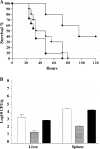Enterococcal leucine-rich repeat-containing protein involved in virulence and host inflammatory response
- PMID: 17620355
- PMCID: PMC1951196
- DOI: 10.1128/IAI.00279-07
Enterococcal leucine-rich repeat-containing protein involved in virulence and host inflammatory response
Abstract
Enterococcus faecalis is an important nosocomial pathogen associated with high morbidity and mortality for patients who are immunocompromised or who have severe underlying diseases. The E. faecalis genome encodes numerous surface-exposed proteins that may be involved in virulence. This work describes the characterization of the first internalin-like protein in E. faecalis, ElrA, belonging to the recently identified WxL family of surface proteins. ElrA contains an N-terminal signal peptide for export, a leucine-rich repeat domain that may interact with host cells, and a C-terminal WxL domain that interacts with the peptidoglycan. Disruption of the elrA gene significantly attenuates bacterial virulence in a mouse peritonitis model. The elrA deletion mutant also displays a defect in infection of host macrophages and a decreased interleukin-6 response in vivo. Finally, elrA expression is induced in vivo. Altogether, these results demonstrate a role for ElrA in the E. faecalis infectious process in vivo and suggest that this surface protein may contribute to E. faecalis virulence by stimulating the host inflammatory response.
Figures





References
-
- Amer, A. O., and M. S. Swanson. 2002. A phagosome of one's own: a microbial guide to life in the macrophage. Curr. Opin. Microbiol. 5:56-61. - PubMed
-
- Baldassarri, L., L. Bertuccini, R. Creti, P. Filippini, M. G. Ammendolia, S. Koch, J. Huebner, and G. Orefici. 2005. Glycosaminoglycans mediate invasion and survival of Enterococcus faecalis into macrophages. J. Infect. Dis. 191:1253-1262. - PubMed
-
- Bell, J. K., G. E. Mullen, C. A. Leifer, A. Mazzoni, D. R. Davies, and D. M. Segal. 2003. Leucine-rich repeats and pathogen recognition in Toll-like receptors. Trends Immunol. 24:528-533. - PubMed
Publication types
MeSH terms
Substances
LinkOut - more resources
Full Text Sources
Molecular Biology Databases

